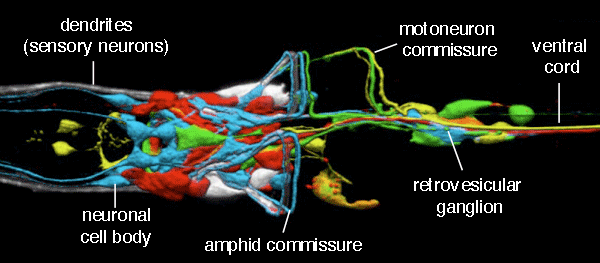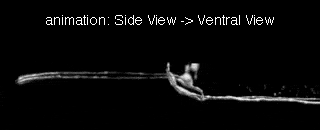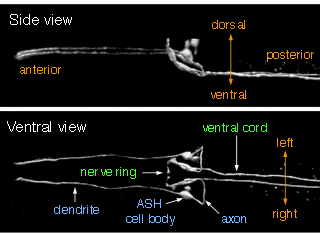C. elegans nervous system

Figure 1: C. elegans nervous system: all neurons labelled with a fluorescent marker (GFP)
The nervous system is by far the most complex organ in C. elegans. Almost a third of all the cells in the body (302 out of 959 in the adult hermaphrodite to be precise) are neurons. 20 of these neurons are located inside the pharynx, which has its own nervous system. The remaining 282 neurons are located in various ganglia in the head and tail and also along the ventral cord, the main longitudinal axon tract. The majority of the neurons develops during embryogenesis, but 80 neurons - mainly motoneurons - develop postembryonically. The structure of the nervous system has been described in unprecedented detail by electron microscopic reconstruction (White et al., 1986). The high resolution obtained with electron microscopic images allowed White and colleagues to identify all the synapses (about 5000 chemical synapses, 2000 neuromuscular junctions and some 500 gap junctions), map all the connections and work out the entire neuronal circuit.
The C. elegans brain

Figure 2: C. elegans head region, ventral view: various classes of neurons labeled in different colors.
The majority of the neurons is located in the head, where they are organised in a number of ganglia surrounding the pharynx, forming the brain of the animal (Figure 2, pharynx not visible). 68 neurons are sensory neurons detecting various soluable and volatile chemicals, tactile stimuli and temperature. These sensory neurons, especially chemosensory neurons (all the white and most of the blue neurons in Figure 2), make up a large fraction of the neurons in the head ganglia. They send their dendrites to the tip of the nose (to the left, but outside the actual picture in Figure 2), which is richly innervated with several sensory structures. Sensory axons join a large axon bundle, the nerve ring (see Figure 3), where they make synaptic connections with interneurons. Some of these interneurons (red neurons in Figure 2) in turn send long axons into the ventral cord, which runs the entire length of the animal. The command interneurons of the motorcircuit connect to motoneurons located in the ventral cord, which in turn connect to muscle cells allowing the animal to respond to sensory input by changing its movement pattern.


Figure 3: ASH sensory neurons in the head. Surface rendering of confocal images.
Anatomy of a single neuron
Individual neurons in vertebrates are typically highly branched with a complex morphology of their processes (axons and dendrites). In C. elegans almost all neuronal processes are unbranched and extend in a stereotpical fashion. The example in Figure 3 shows a pair of sensory neurons (ASH) with cell bodies located in head ganglia. The two ASH neurons are chemosensory neurons. A single process, the dendrite, extends from the cell body towards the tip of the nose. A second process, the axon, grows first towards the ventral cord through the amphid commissure. It then turns anteriorly and loops in a halfcircle around the pharynx (not visible) within a large axon bundle - the nerve ring (note: the processes in the ventral cord in the figure belong to a second pair of neurons (PVQ) with cell bodies in the tail). The nerve ring is a horseshoe-shaped axon bundle containing neuronal processes of sensory and interneurons which form connections (synapses) as they run next to each other.
The invariant anatomy and the simple neuronal morphology makes it very easy to detect even minor developmental defects and make C. elegans one of the favourite model organisms to study neuronal development.